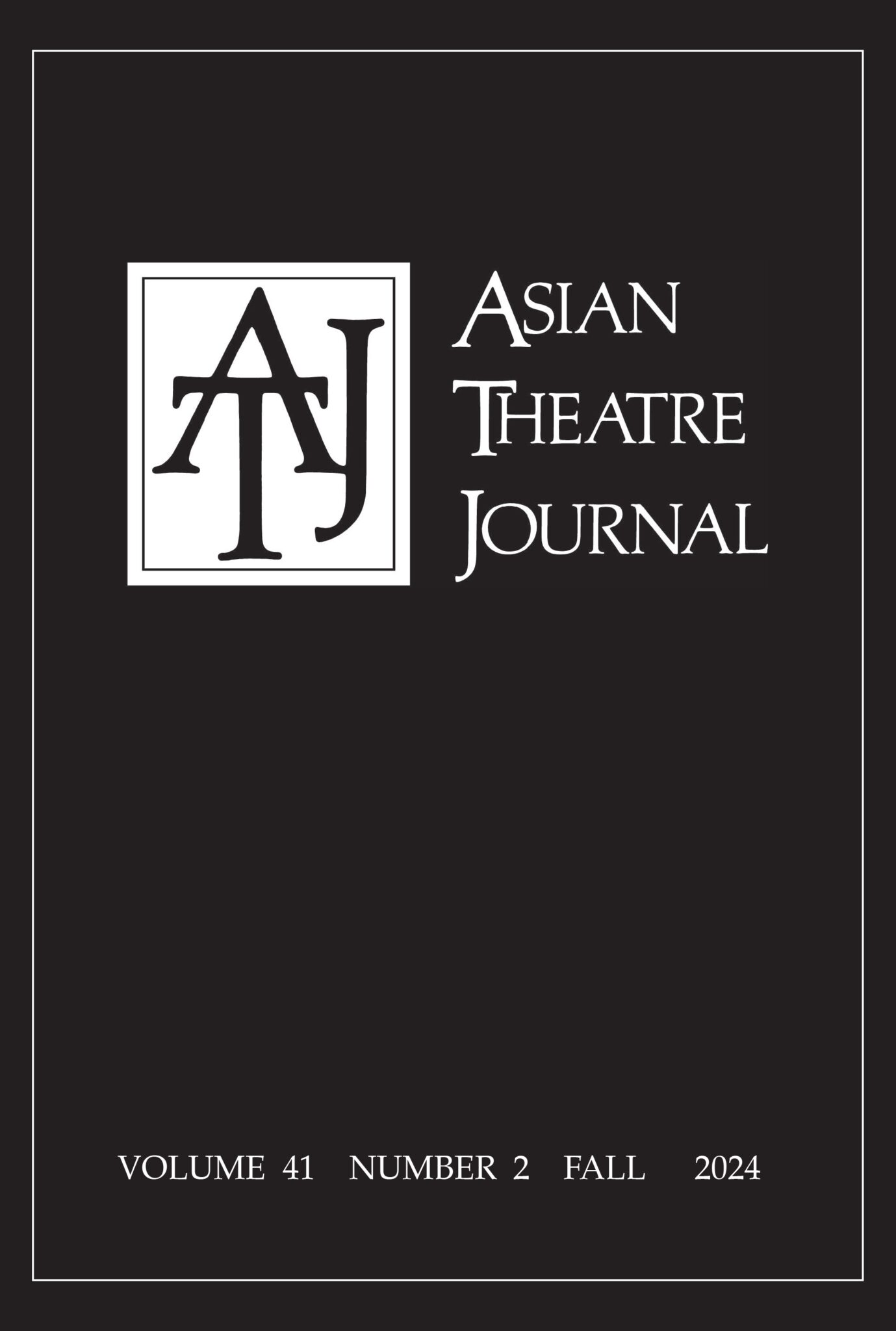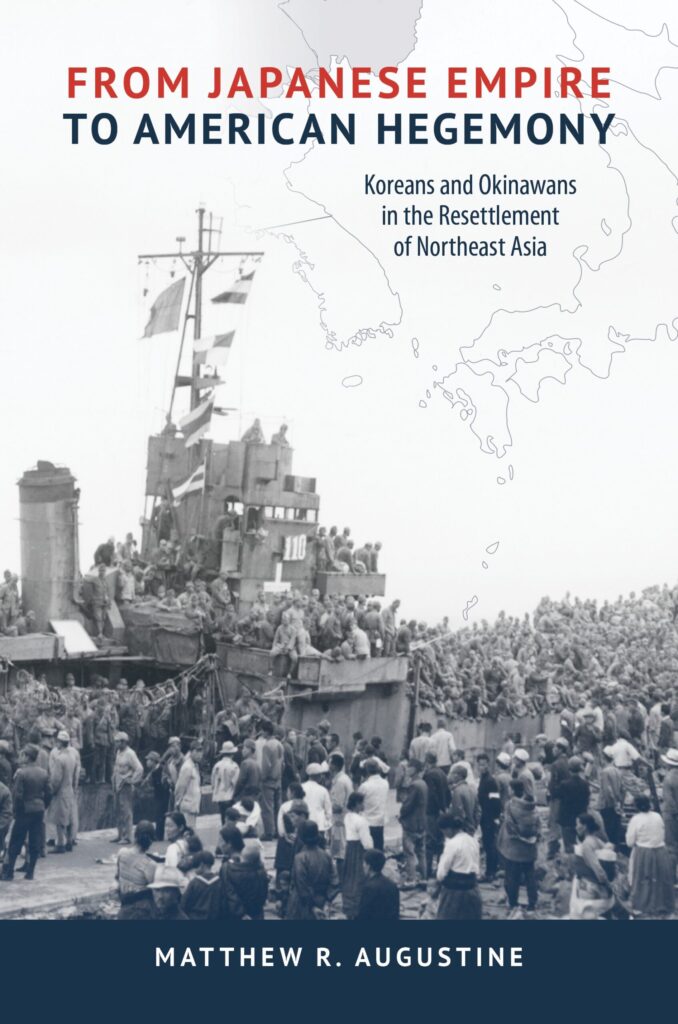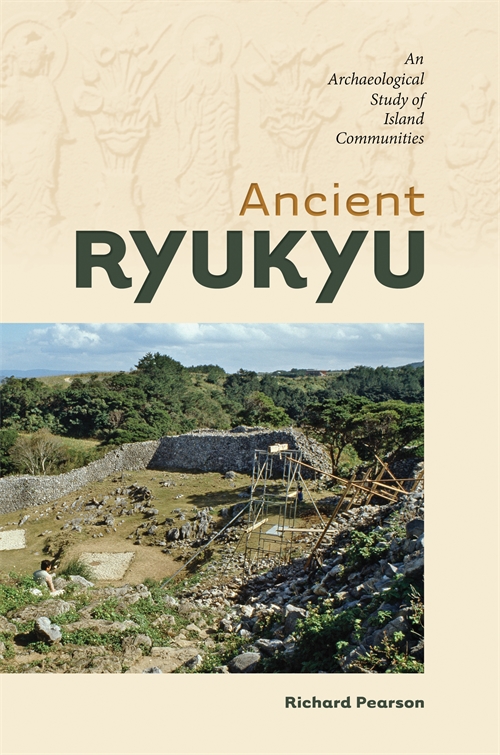Category: Asia
30% OFF OKINAWA LANGUAGE AND HISTORY

ICHARIBA CHOODEE!
Meet Niko, an exchange student, and his Okinawan host family. Together they provide a friendly introduction to Okinawan culture and language through conversations about everyday life and their adventures around Okinawa.







LOOKING FOR MORE OKINAWA LANGUAGE AND HISTORY?

OKINAWAN-ENGLISH WORDBOOK
The Okinawan-English Wordbook, written by the late Mitsugu Sakihara, historian and native speaker of the Naha dialect of Okinawa, is a concise dictionary of the modern Okinawan language with definitions and explanations in English. The first substantive Okinawan-English lexicon in more than a century, it represents a much-needed addition to the library of reference materials on the language.

EARLY RYUKYUAN HISTORY: A NEW MODEL
The Ryukyu islands have been inhabited by humans for over 30,000 years. Their modern population, however, did not come from stone-age ancestors, nor did distinctive forms of Ryukyuan culture, such as sacred groves or stone-walled castles, emerge from within the islands. Instead, different groups of people lived in the Ryukyu islands at various points in history. Starting with the earliest extant human remains and ending with the formation of a centralized state in the early 1500s, Early Ryukyuan History traces the people, culture, technologies, goods, and networks that entered different parts of Ryukyu over time. In the process, it synthesizes decades of research in archaeology and anthropology, recent advances in genetic evidence, and conventional documentary sources to advance a new model for the early development of the Ryukyu islands, thoroughly rewriting early Ryukyuan history.
30% OFF SELECT ASIAN STUDIES TITLES

SEE OUR NEW RELEASES BELOW
CLICK HERE FOR OUR FULL LIST OF 30% OFF TITLES
30% OFF on Music and Performing Arts of Asia and the Pacific
USE CODE SEM2023
Free U.S. domestic shipping on orders of $100 or more
Offer ends November 30, 2023
CLICK HERE FOR MORE INFORMATION ABOUT THE MUSIC AND PERFORMING ARTS OF ASIA AND THE PACIFIC SERIES
Online only. Must be in stock. No phone orders. No combined coupons. Allow 2-6 weeks for delivery.
Continue reading “30% OFF on Music and Performing Arts of Asia and the Pacific”
Korean Studies Special Section: Music That Moves
This year’s issue of Korean Studies (Volume 46) features a special section, “Music That Moves: Sonic Narratives in Modern Korea,” guest edited by Dafna Zur and Susan Hwang. The six articles that comprise this section explore transnational religiosity and Cold War politics, resistance in protest songs, North Korea’s sonic culture, South Korea’s use of K-pop in marketing and more.
Here guest editors Dafna Zur and Susan Hwang discuss the “Music that Moves.”


Left: Susan Hwang (courtesy of author). Right: Dafna Zur (Do Pham / Stanford University)
University of Hawai‘i Press: Tell us how this special section came together.
Zur and Hwang: We have been working together for the last few years as members of the LLC Korean Forum at the Modern Language Association. When it was our turn to brainstorm panel ideas for the MLA’s annual convention, we landed on music. We realized that we had a lot in common—we were both trained as literary scholars, but we wanted to explore the relationship between music and text. Our panelists presented their work in January 2021, and this volume is a result of that panel.
UHP: This special section engages with Korean music from a multi-disciplinary perspective. Why was this important to you?
Editors: Although the contributors in our special section come from different disciplinary backgrounds—musicology, ethnomusicology, history, literature, and cultural studies—music is our common denominator. We gathered a group of scholars who were keen on engaging with different musical forms—music as scores, as voices coming from the throats of children and protesters, as part of mass consumption, as background tracks to epic narratives—and who were willing to cross disciplinary boundaries and think about music as a manifestation of cultural and historical phenomena. As many of us were scholars of text rather than music, we often found ourselves outside our comfort zone—at one point, Dafna consulted her father, a composer, on her musical analysis (he is acknowledged in the footnotes!). We hope to encourage others to take up the study of music in its multiple forms.

UHP: In addition to multiple disciplines, the articles cover a substantial period of time, from the colonial period to the 21st century. Overall, do you see any patterns in Korean music over time? Or perhaps change or conflicts?
Editors: Our project demonstrates that a broad historical perspective can highlight both the transnational and local qualities of Korean music. We cover, for instance, the impact of Western music on Korean composers who wrote children’s songs, the mobilization of affect through Christian hymns and sounds of war, and the revitalization of kut in modern practice of “folk” culture and the branding power of K-pop. Besides bringing attention to the qualities of music across time and in different geographic locations, our project also stays attentive to the richness of musical genres—songs, sound effects, accents and vocalization, background tracks—that lend themselves to textual and musical analysis.

UHP: Why, in your opinion, is this special section important now?
Editors: For the last 15-20 years, Korean studies has enjoyed a surge of interest in the study of Korean culture and language, especially among high-school and college students. This success is largely thanks to the explosive popularity of K-pop around the globe. We continue to witness the power of music, such as civic engagement and political solidarity, that emerges from K-pop fandom. Two interrelated questions that the papers in this special section address are, how did the forces of social change and technological innovations impact the way people engage with music, and how did music as an affective force facilitate paradigmatic shifts in modern Korean history? It was important for us to show alternative forms of Korean music that have contributed to its enduring power.
UHP: How do you hope readers will utilize this special section in their own work?
The articles in the special section deal with a wide range of genres and sonorities from different historical periods. There are YouTube links to music in many of them. We hope scholars will find our articles accessible and teachable, and that the articles will contribute to our ongoing efforts to contextualize the current moment of Korean music’s success.
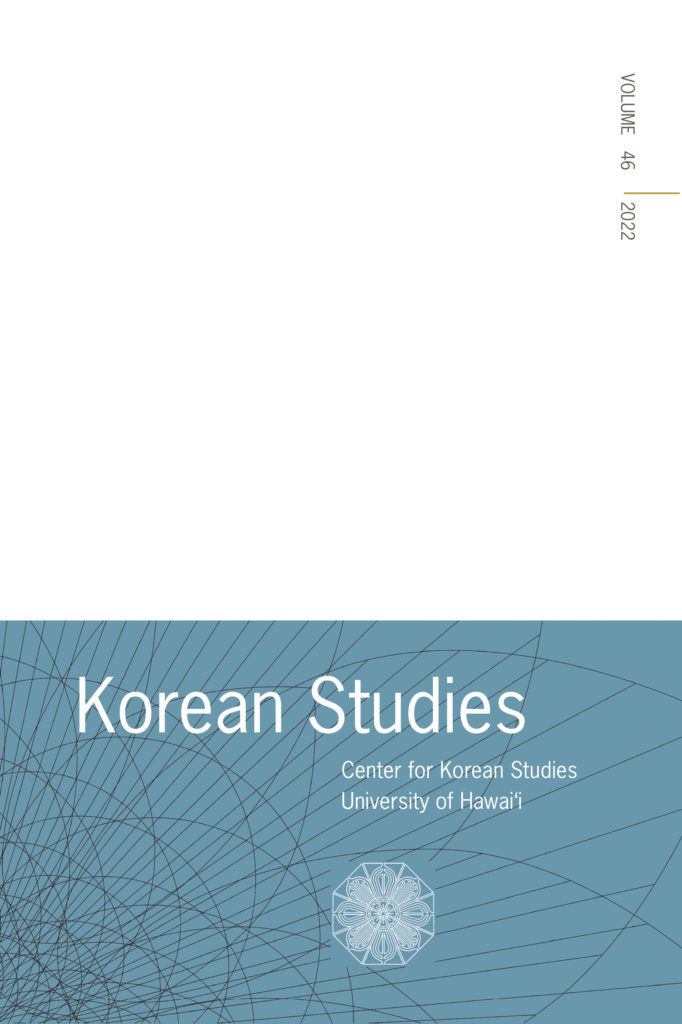
Table of Contents
Editor’s Note
Cheehyung Harrison Kim
Special Section
Music That Moves: Sonic Narratives in Modern Korea
Introduction to the Special Section
Dafna Zur and Susan Hwang
When Songs Don’t Work: Western Tonalities and Korean Breath in Children’s Songs of the Colonial Period
Yoon Joo Hwang and Dafna Zur
From Waifs to Songbirds: The World Vision Korean Orphan Choir
Katherine In-Young Lee
From McArthur’s Landing to Trump’s Fire and Fury: Sonic Depictions of Struggle and Sacrifi ce in a North Korean Short Story, Film, and Opera
Alexandra Leonzini and Peter Moody
What’s for Sale? Selling Songs and K-pop Idols in Korean Commercials
Roald Maliangkay
Subscribe to Korean Studies
Honoring David L. Rolsten, Sonic Narratives in Modern Korea + Girls in Japanese Literature

CHINOPERL
Volume 41, Number 1 (2022)
Special Issue: Honoring David L. Rolston
Associate Editor Catherine Swatek and Editorial Board Member Robert E. Hegel remember Rolston in the following introduction:
Given his publication record, one might assume that David L. Rolston is a scholar of narrative fiction. For his first major publication, David served as editor of How to Read the Chinese Novel, a milestone in providing English-language readers a glimpse of reading practices and practical criticism contemporaneous with Ming and Qing novels themselves. Not merely the compiler of the translations that comprise six of the book’s seven chapters, David’s work can be seen throughout the volume, from adding innumerable notes and explanations to the “How to Read” (dufa讀法) translations; to writing essays on the sources, history, and formal aspects of traditional fiction criticism; to compiling explanatory appendices and an extensive bibliography for each of the masterworks covered. This project was completed before David finished his Chicago doctorate.
Find more special features and articles at Project MUSE.

Korean Studies
Volume 46, Number 2 (2021)
Special Section: “Music That Moves: Sonic Narratives in Modern Korea”
This Special Section features discussion on 1960’s protect songs to K-pop idols. Editor Cheehyung Harrison Kim notes:
Culture is at once a medium through which we make sense of the
world (for good or ill), a field of empowerment for the underprivileged, and a source of hegemony for the state and corporations. This cultural complexity is discernible in South Korea’s current political landscape, and it is also the very theme explored in this volume’s Special Section “Music That Moves: Sonic Narratives in Modern Korea,” dexterously guest edited by Dafna Zur and Susan Hwang. In Katherine Lee’s elegant piece on the World Vision Korean Orphan Choir, musical performance is at the heart of transnational religiosity and Cold War politics. Transnationalism is also the framework of Dafna Zur and Yoon Joo Hwang’s original research on children’s music during the colonial period, when the merger between western style of songwriting and Korean emotionality unevenly transpired in the genre of tongyo. Music as a field of popular resistance is the core of Pil Ho Kim’s audacious piece on South Korea’s 1960s protest songs, which, for Kim, is a pre-minjung expression of the multitude. Susan Hwang’s emotionally prodigious article, too, is on the resistive and resilient aspect of music, which, in the aftermath of the 1980 Kwangju Uprising, served as a crucial repertoire for the counter-state. From the opposite side, music as practice of hegemonic efficacy is dealt with in Alexandra Leonzini and Peter Moody’s intricate article on North Korea’s sonic culture, as it is done in Roald Maliangkay’s perspicacious study on South Korea’s use of K-pop in marketing. Whether the hegemonic entity is the state or a corporation, music is, in these two articles, a potent medium of influence.
Find more special features and articles at Project MUSE.

U.S. Japan Women’s Journal
Volume 62 (2022)
Special Issue: Girls and Literature
As expressed by authors Hiromi Tsuchiya Dollase and Wakako Suzuki in the introduction:
The literary genre shōjo shōsetsu emerged in conjunction with the rise of girls’ education in the Meiji period. Early stories were meant to educate readers to become “good wives and wise mothers.” Accordingly, shōjo shōsetsu endured restrictions on the narratives they could tell, limiting the breadth of their authors’ artistic and literary possibilities. Shōjo shōsetsu evolved and diversified in the postwar era and, especially starting in the 1980s, became a means for young female authors to empower themselves. Shōjo shōsetsu have declined in popularity recently as readers consume stories more broadly across media and genres. The goal of this special issue is to contemplate the function, meanings, and problems of shōjo shōsetsu. Instead of merely confining ourselves to a rigid, unified notion of shōjo shōsetsu, we consider shōjo characters from the wider literary world, investigating their roles, functions, and cultural implications.
The new issue includes the following articles:
Introduction: Girls and Literature
イントロダクション:少女と文学
Hiromi Tsuchiya Dollase and Wakako Suzuki
Trees That Grow Kimono (1895)
着物のなる木
Wakamatsu Shizuko 若松賤子
Translated by Wakako Suzuki
Kawabata Yasunari’s The Scarlet Gang of Asakusa as the
Territory of the Dispossessed Girl
追い立てられた少女の領域としての『浅草紅団』
Barbara Hartley
Love and Sexuality in Postwar Girls’ Culture: Examining
Tomishima Takeo’s Junior Fictiona
戦後少女文化における恋愛と性愛:富島健夫の
ジュニア小説をめぐって
Hiromi Tsuchiya Dollase
Countdown to the Demise of Girls’ Novels
少女小説のカウントダウンの開始
Kume Yoriko 久米依子
Translated and Introduced by Barbara Hartley
Find more articles at Project MUSE.
Special Features: Korean LGBTQ+ Literature, Remembering Linguists Robert Andrew Blust and Thomas Edward Dutton and more

Azalea
Volume 15 (2022)
From the editor Young-Jun Lee:
A century’s worth of change looks quite remarkable in Korean literature. Today’s young Koreans cannot read the same newspapers read by their grandparents’ generation. In less than a hundred years, the national written language has shifted from Chinese characters to Korean hangul, then briefly to Japanese as enforced under colonial rule, and then to the modern Korean language that we know today. During this process, remarkable sociocultural transformations dominated daily life. Over the first half of the 20th century, Koreans endured enormous political shifts most notably marked by colonization, the Korean War, and the ensuing divide of the country into separate political nations. Along the way, Korean literature registered these upheavals and fluctuations.
Notably, the literature of totalizing grand narrative, which concerned itself with the trajectory of nation-building, persisted in Korea until the 1980s. Ever since the end of the military dictatorship and the establishment of a civil government in the 1990s, however, that literature began to shift its focus to the lives of women. Now, those long ignored and marginalized—including queer women, as well as other queer people such as those who are non-binary— have also begun to emerge more strongly as published authors, even as they have been increasingly centered as subjects of literary narratives. The ongoing impact of this inclusive, expansionary shift
can be seen directly in AZALEA’s decision to focus on LGBTQ+ literature for its fifteenth issue.
Find more poetry, fiction, graphic shorts, and images at Project MUSE.
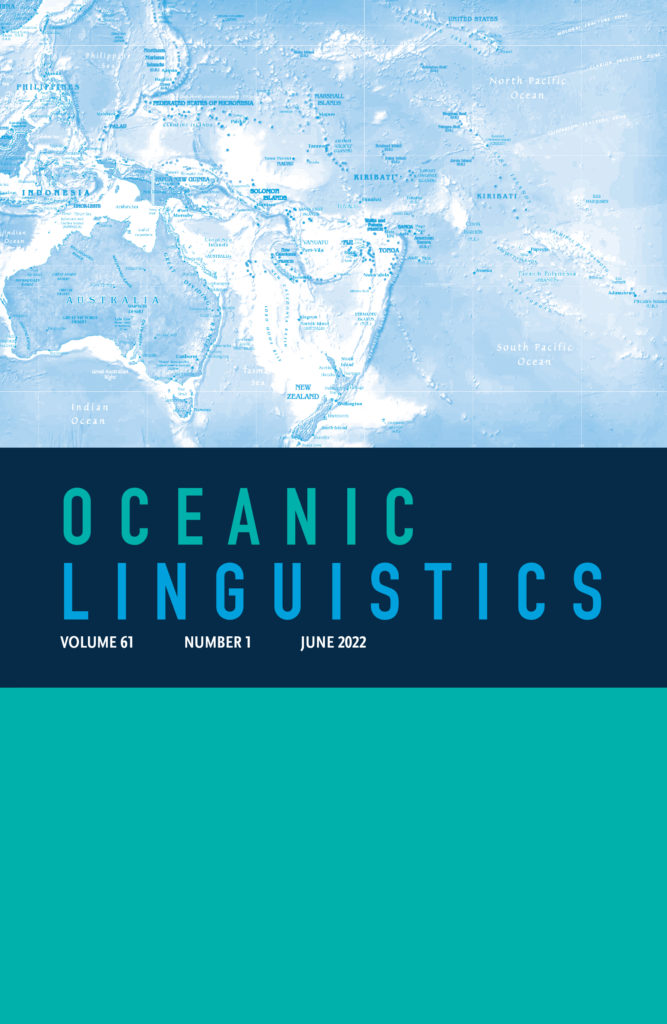
Oceanic Linguistics
Volume 61, Number 1 (2022)
The new issue includes the following articles and reviews:
The Place of Space in Oceanic Linguistics
Leah Pappas and Alexander Mawyer
Semantics and Pragmatics of Voice in Central Malagasy Oral Narratives
Penelope Howe
On the Nature of Proto-Oceanic *o in Southern Vanuatu (and Beyond)
John Lynch
Rare, but Real: Native Nasal Clusters in Northern Philippine Languages
Robert Blust
The Greater West Bomberai Language Family
Timothy Usher and Antoinette Schapper
The Phonology and Typological Position of Waima’a Consonants
Kirsten Culhane
Find more research articles, squibs, and reviews at Project MUSE.
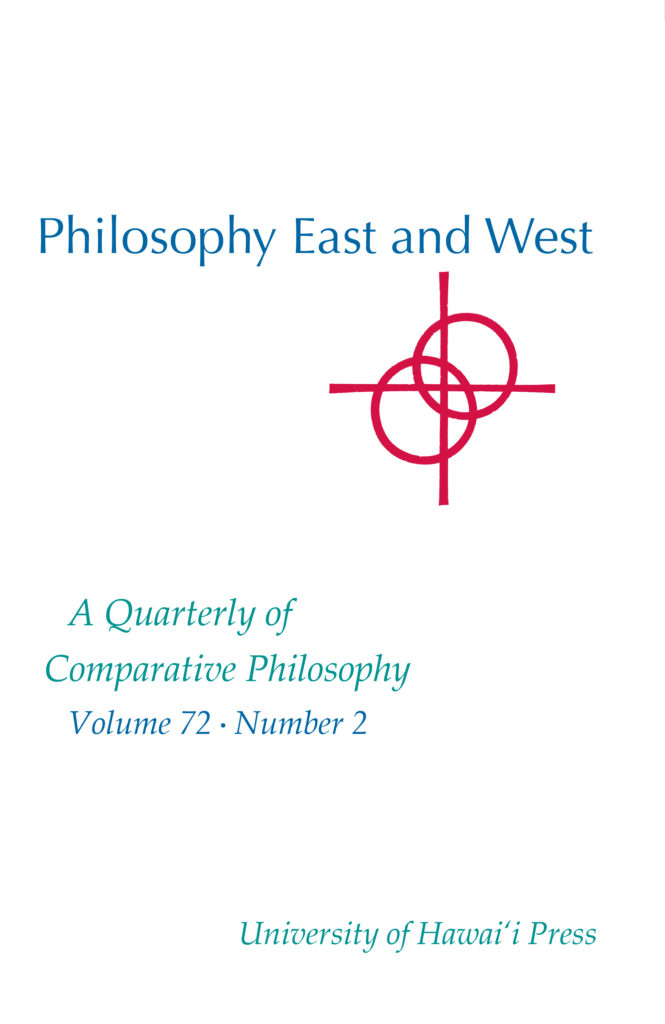
Philosophy East and West
Volume 72, Number 2 (2022)
Includes the following articles and discussions:
Bhāviveka’s Inclusivism: Discriminating the Feces, Jewels, and Fake Jewels of the Veda
Hyoung Seok Ham
Buddhist Ethics as a Path: A Defense of Normative Gradualism
Javier Hidalgo
For Glory and for Sport: Jonathan Edwards and the Vedanta School on God’s Motive for Creating the World
Daniel M. Johnson
Kumārila Bhaṭṭa and Pārthasārathi Miśra on First- and
Higher-Order Knowing
Malcolm Keating
Is Zhuangzi a Patient Relativist?: A Response to Yong Huang Jianping Hu
Find more articles, discussions, and reviews at Project MUSE.
New Journal Issues: Aloha Shirt Aesthetics, Patterns of Mortuary Practice in Vanuatu, Taiwan Sugar in the 1600s + More

Asian Perspectives
Volume 61, Number 1 (2022)
The new issue includes the following articles and reviews:
Lakheen-Jo-Daro, an Indus Civilization Settlement at Sukkur
in Upper Sindh (Pakistan): A Scrap Copper Hoard and
Human Figurine from a Dated Context
Paolo Biagi and Massimo Vidale
The Hamin Mangha Site: Mass Deaths and Abandonment
of a Late Neolithic Settlement in Northeastern China
Yawei Zhou, Xiaohui Niu, Ping Ji, Yonggang Zhu, Hong Zhu, and
Meng Zhang
Early Metal Age Settlement at the Site of Palemba, Kalumpang,
Karama Valley, West Sulawesi
Anggrreani
Patterns of Mortuary Practice over Millennia in Southern Vanuatu,
South Melanesia
Frédérique Valentin, Wanda Zinger, Alison Fenwick, Stuart Bedford,
James Flexner, Edson Willie, and Takaronga Kuautonga
Find more research articles and reviews at Project MUSE.


Biography
Volume 44, Issues 2 & 3 (2021)
Special Double Issue: Graphic Medicine
Graphic Medicine’s Possible Futures: Reconsidering Poetics and Reading
Erin La Cour and Anna Poletti
Conflict or Compromise?: An Imagined Conversation
with John Hicklenton and Lindsay Cooper about
Living with Multiple Sclerosis
John Miers
Out of Sync: Chronic Illness, Time, and Comics Memoir
Jared Gardner
Face as Landscape: Refiguring Illness, Disability,
and Disorders in David B.’s Epileptic
Erin La Cour
Graphic Confessions and the Vulnerability Hangover
from Hell
Safdar Ahmed
Drawn to History: Healing, Dementia, and the Armenian
Genocide in the Intertextual Collage of Aliceheimer’s
Crystal Yin Lie
Find more at Project MUSE.
Biography
Volume 44, Issue 4 (2021)
Open Forum Articles
Reviews
Editor Craig Howes embraces this volume as he explains:
“The latest issue of Biography qualifies as special because of its ordinariness. After a four-installment run featuring two special issues, an inaugural Forum, and the Annual Bibliography and International Year in Review, we now return to our regularly scheduled programming. Articles and book reviews—that’s all!
But the table of contents for this issue speaks to what has distinguished Biography for decades as a quarterly. First, the articles. Their geographic, historic, linguistic, and generic range is in keeping with our international and interdisciplinary profile. American celebrity biographies and philosophy, twentieth-century Indian regional autobiography, modernist Austrian psychoanalytic biography, post-WWII German-Romanian autofiction, contemporary Palestinian auto/biographical texts—our pages map out and tell the stories of the field.”
Find more articles and reviews at Project MUSE.
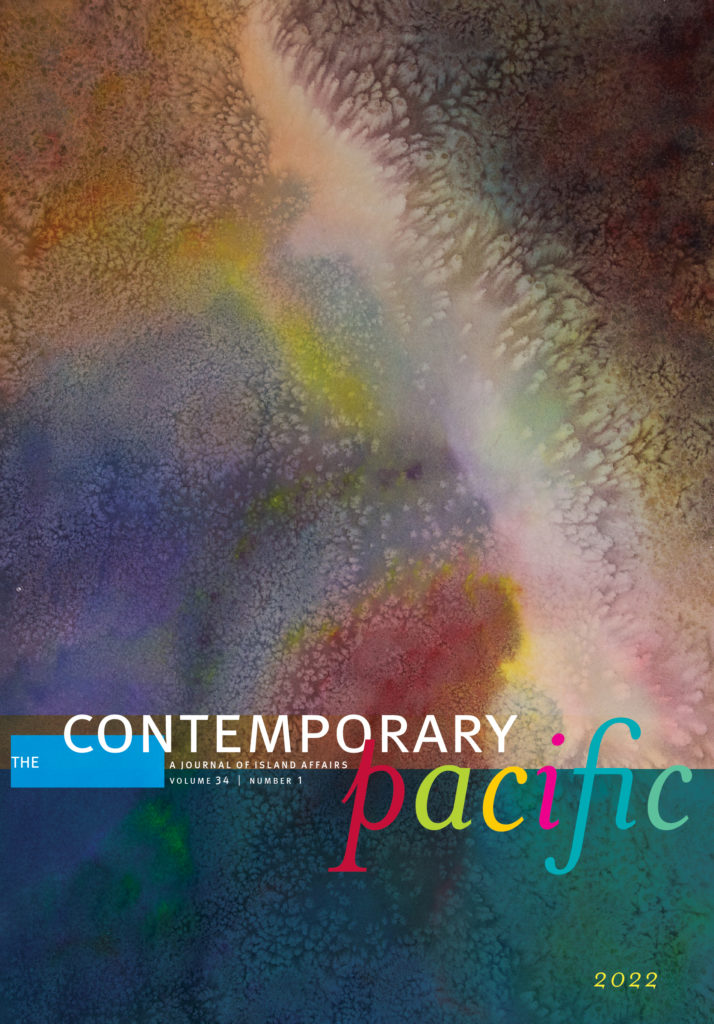
The Contemporary Pacific
Volume 34, Issue 1 (2022)
The new issue includes the following articles, dialogues, political, media, and book reviews.
One Salt Water: The Storied Work of Trans-Indigenous Decolonial Imagining with West Papua
Bonnie Etherington
Making Sartorial Sense of Empire: Contested Meanings
of Aloha Shirt Aesthetics
Christen T Sasaki
The Compensation Page: News Narratives of Public Kinship in Papua New Guinea Print Journalism
Ryan Schram
“We Are So Happy EPF Came”: Transformations of Gender in Port Moresby Schools
Ceridwen Spark and Martha Macintyre
Pacific People Navigating the Sacred Vā to Frame Relational Care: A Conversation between Friends across Space and Time
Silia Pa‘usisi Finau, Mele Katea Paea, and Martyn Reynolds
Find more articles, dialogues, political, media, and book reviews at Project MUSE.


The Journal of Burma Studies
Volume 26, Number 1 (2022)
Ritual and Play in Buddhist Nun-Making: Girlhood,
Nunhood, and the Shaping of the “Little Teacher” in
Today’s Myanmar
Rachelle Saruya
From Archenemy of the Nation to the Intimate
Other: Prince Damrong Rajanubhab’s Journey
through Burma and the Colonial Ecumene
Thanapas Dejpawuttikul
Military Rule with a Weak Army: Myanmar’s
Late Expansion
Marie-Eve Reny
Grassroots Roles and Leadership Aspirations:
The Experiences of Young Ethnic Women in
Myanmar Civil Society Organizations
Maaike Matelski and Nang Muay Noan
Find more captivating articles at Project MUSE.
Journal of World History
Volume 33, Number 2 (June 2022)
The “Material Turn” in World and Global History
Giorgio Riello
From the Atlantic to the Manchu: Taiwan Sugar and the Early Modern World, 1630s–1720s
Guanmian Xu
The Myth of Immobility: Women and Travel in the British Imperial Indian Ocean
Scott Reese
Religion and the Contemporary Phase of Globalization: Insights from a Study of John Paul II’s World Youth Days
Charles Mercier
Find more research articles and reviews at Project MUSE.
Journal of World History Special Issue: Missions & Conversions in World History – Free!
The World History Association will be hosting its annual meeting in-person and virtually in Bilbao, Spain from June 23 to 25, on the theme “Distance, Mobility, and Migration.” The Journal of World History offers this accompanying special collection “Missions and Conversions in World History,” free on the Project MUSE platform through September 30. Select World History Titles in our Books Department will also be 30% July 1 through September 30 with coupon code WHA2022.
Missionary efforts are usually enacted on a global scale and have been an important force within world history. This special collection of articles seeks to enhance our understanding of missionaries and conversion and their place in the discourse on religion in world history. Some of the articles in this special collection focus on the religious beliefs of the missionaries and converts, and how those beliefs adapted to the cultures of parties. Other contributors analyze the political ramifications of missionary undertakings, while still others explore the varied cultural exchanges and entanglements which result from these encounters, many of which extended beyond the religious.
This special issue provides accessible resources for scholars and teachers worldwide and features Guest Editor Stephen S. Francis, who discusses the issue below.

(Photo courtesy of Stephen S. Francis)
University of Hawai‘i Press: Tell us how this special issue came together.
Stephen S. Francis: My personal area of research is the history of religion and society, and also family relations and material culture, so I was drawn to these articles that not only dealt with the personal ideological conversion of peoples, but also how missionaries and religion affected other aspects of society and culture beyond the intended reasons for proselyting.
UHP: Why is this issue important now?
SSF: Since the latter half of the twentieth century and the beginning of the twenty-first, religion throughout the world has undergone radical change, but perhaps no more so than in the past. So, I think it is beneficial for us to look at the impact and effects of past encounters to place the current developments in context.
UHP: How do you hope people will use this issue?
SSF: One of the goals of Journal of World History is to show broader interconnections of ideas that go beyond nations and regions, and in editing this volume, I gained greater insight into my own localized study by seeing the similarities and how my own work fits into this larger discourse. I hope that other scholars will do the same, and that it will enhance their own research and world view.
UHP: How are things changing as the world has reopened slowly? Are there many ways the pandemic has affected your own research and teaching?
SSF: Specifically regarding the topic of this issue, I know that several churches have altered the way they have proselyted during the pandemic, and I am eager to see how some of those changes will be kept and what ones will be discarded as the world reopens, which in several years will be fascinating to research. I, like many, had to cancel research trips due to the pandemic, but it also gave me time to reflect and focus on ideas that I may have ignored if life had continued as “normal.”

Missions & Conversions in World History
Table of Contents
“Missions and Conversions in World History: An Introduction”
Stephen S. Francis
Indigenous Encounters with Christian Missionaries in China and West Africa, 1800-1920: A Comparative Study
David F. Lindenfeld
American Missionaries and the Opium Trade in Nineteenth-Century China
Michael C. Lazich
The Intricacies of Accommodation: The Proselytizing Strategy of Matteo Ricci
Yu Liu
“A Missionary from the East to Western Pagans”: Kagawa Toyohiko’s 1936 U.S. Tour
Robert Shaffer
From Transformation to Negotiation: A Female Mission in a “City of Schools”
Julia Hauser
“Not Far from the Kingdom of God”: Shamanism and Colonial Control in Russia’s Eastern Borderlands, 1853–1917*
Jesse D. Murray
The Jesuit Heresiological Discourse as an Enlightenment Project in Early Modern China
Qiong Zhang
The New Woman, Her New Clothes, and Her New Education: Missionary Encounters and Consuming the Exotic
Mona L. Russell
The World History Association will host its annual meeting both in-person and virtually, from June 23 to 25, on the theme “Distance, Mobility, and Migration.” The Journal of World History offers this digital special issue “Missions and Conversions in World History” free on the Project MUSE platform through the end of September 2022. Select World History Titles in our Books Department will also be 30% July 1 through September 30 with coupon code WHA2022.

New Journal Special Issues: The Religiosity of Tonghak, Vietnamese Linguistics + More

China Review International
Volume 17-1 (2020)
Between Disaster, Punishment, and Blame: The Semantic Field of Guilt in Early Chinese Texts by Thomas Crone (review)
Michael Nylan
Dictatorship by Degrees: Xi Jinping in China by Steven P. Feldman (review)
John Sagers
Confucianism and Sacred Space: The Confucian Temple from Imperial China to Today by Chin-shing Huang (review)
Deborah Sommer
The Inconvenient Generation: Migrant Youth Coming of Age on Shanghai’s Edge by Minhua Ling (review)
Yinni Peng
Queer Chinese Cultures and Mobilities: Kinship, Migration, and Middle Classes by John Wei (review)
Shunyuan Zhang
Find more articles at Project MUSE.

Journal of Korean Religions
Special Issue: The Religiosity of Tonghak
Volume 13, Number 1 (2022)
The new issue includes the following articles and reviews:
The Philosophical Turn in Tonghak: Focusing on the Extension of Ethics of Ch’oe Sihyŏng
Cho Sŏng-hwan
The Faith of Sich’ŏnju in Tonghak/Ch’ŏndogyo and its Method
of Practice
Kim Yonghae
Find more research articles and reviews at Project MUSE.

Journal of the Southeast Asian Linguistic Society
Special Issue:
Vietnamese Linguistics: State of the Field
The new issue features the following introduction by Trang Phan, John Phan, and Mark J. Alves
The current issue is the result of a workshop held at the Harvard Yenching Institute in April of 2021, entitled Vietnamese Linguistics, Typology and Language Universals, and which featured nineteen linguists working on diverse aspects of the Vietnamese language, ranging from semantics to historical phonology. Our purpose in gathering was to take stock of the great leaps in Vietnamese linguistic research that have occurred over the past few decades, to bring together cutting-edge research from each subdiscipline, and to begin a new collaborative dialogue on Vietnamese linguistics, typology, and language universals. Most of all, it was our belief that the time had come to reconsider Vietnamese linguistics as a unified field of inquiry. As a result, a new academic organization was founded: the International Society of Vietnamese Linguistics.
In the past twenty years, research into the Vietnamese language has advanced exponentially, in tandem with developments in our understanding of syntax, semantics, phonetics, and phonology—both on the synchronic and diachronic levels. Specific work on the Vietnamese language now informs and even leads broader linguistic inquiry in a number of unprecedented ways. These new developments invite a concentration of state-the-field research into a single volume, one that will serve not only to summarize current issues in each subdiscipline of Vietnamese linguistics, but also to initiate a longer, more collaborative conversation about the Vietnamese language.
Our goals in this special issue are thus twofold: first, we seek to provide a snapshot of current research into Vietnamese syntax, semantics, phonology, and phonetics, from both the historical and synchronic points of view, that may serve as a resource for linguists interested in exploring our current understanding of the Vietnamese language. Second, we hope that this issue will also serve as an invitation to all linguists working on the Vietnamese language or related languages to contribute to a broader, more cosmopolitan discussion—one in which discoveries of one subdiscipline may serve to inform or enlighten another.
Find more articles at eVols.

U.S. – Japan Women’s Journal
Volume 61 (2022)
The new issue features the following articles:
“Unseasonal Winds of Love”: A History of Prostitution and the Foreign Community in Early Modern Nagasaki
Martha Chaiklin
Historian and Feminist Kanō Mikiyo: A Lifetime of Writing Against Japanese Imperialism
Setsu Shigematsu
The “Emperor’s Heart” and the “Mother’s Heart”: What Gave Rise to the “Mothers of Yasukuni”
Kanō Mikiyo, Setsu Shigematsu
War-Themed Shōjo Manga as a Site for Female Subjectivity: An Aesthetic Analysis of Mothers and Daughters Narrating War
Kaori Yoshida, Kazumi Nagaike
Androids for the Stone Age?: Individuality, Space, and Gender in Murata Sayaka’s Convenience Store Woman
Ronald Saladin
Find more articles at Project MUSE.
New Journal Issues: “Contagious Magic” in Japanese Theatre, Logistics of the Natural History Trade, Hawai‘i’s Toxic Plants + More
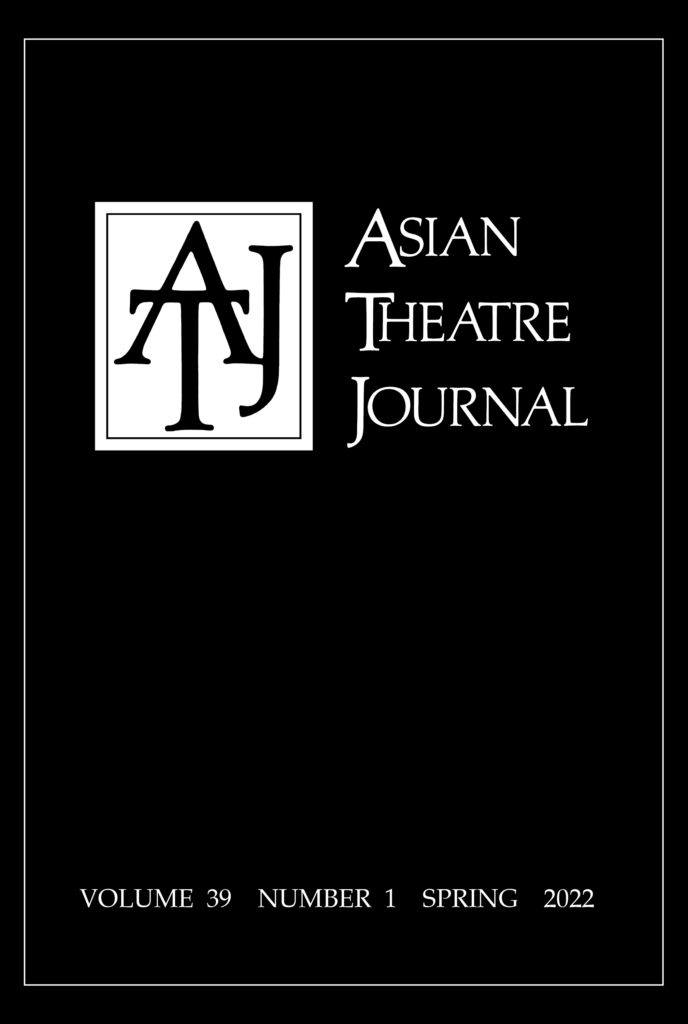
Asian Theatre Journal
Volume 39, Number 1 (2022)
The new issue includes the following translations and articles:
A Journal of the Plague Year by Terayama Shūji in Collaboration
with Kishida Rio: “Contagious Magic” for a Time of Epidemic Translated by Tsuneda Keiko and Colleen Lanki
Yi Kwang-su’s Gyuhan (Sorrows of the Inner Room): Korea’s
First Modern Play?
Introduction and Translation by Owen Stampton
The “Homosexual Code” in Contemporary Korean Theatre:
The Case of Shakespeare’s R & J in Seoul
Yeeyon Im
Isan Contemporary Performance: Embodied Isan Tone in
Thai Contemporary Performance Making
Tanatchaporn Kittikong
Find more translations, articles, and reviews at Project MUSE.

Journal of World History
Volume 33, Issue 1 (2022)
A Short History of Feather Fans’ Spread and Cultural
Connotations: From Bronze Age Africa East to China
and West to Europe
Karen Eva Carr
Breaking the Containment: Horse Trade between the
Ming Empire and its Northern Neighbors, 1368–1570
Liping Wang and Geng Tian
Captive Colonizers: The Role of the Prisoners of War
from Poland-Lithuania and the Crimean Khanate in
the Russian Subjugation of Eastern Siberia
Dariusz Kołodziejczyk
Chains of Custody, Oceans of Instability: The Precarious
Logistics of the Natural History Trade
Vanessa Finney, Jarrod Hore, and Simon Ville
Abie Nathan and his Double-Edged Missions:
The Transnational Humanitarian and Human Rights
Activist during the Nigeria-Biafra War
Taiwo Bello
Find more articles and book reviews at Project MUSE.

Pacific Science
Volume 76, Number 1 (2022)
The new issue includes the following articles:
Spatial and Temporal Patterns of Fire on Saipan, CNMI
Ilan E. Bubb and Zachary B. Williams
Hawai‘i’s Toxic Plants: Species Richness and Species–Area Relationships
Donald K. Grayson and Heidi A. Lennstrom
Factors Affecting Breeding Success of White Terns (Gygis alba; Aves: Laridae) in Urban Environments of Honolulu, Hawai‘i
Eric A. VanderWerf and Richard E. Downs
Validation of the USPED Erosion and Deposition Model at Schofield Barracks, O‘ahu, Hawai‘i
Steven D. Warren and Thomas S. Ruzycki
Behavior of Hawaiian Petrels and Newell’s Shearwaters (Aves: Procellariiformes) Around Electrical-Transmission Lines on Kaua‘i Island, Hawaiian Islands
Robert H. Day and Brian A. Cooper
Epizoic Cyanobacteria and Algae on the Pelage of Pinnipeds:
A Literature Review and New Data for the Harbor Seal (Phoca vitulina)
Floyd E. Hayes, Sarah Codde, and Sarah G. Allen
A Short-Term Winner? Dramatic Increases in the Population of Mushroom Coral Lobactis scutaria (Anthozoa: Fungiidae) in Ka-ne‘ohe Bay, Hawai‘i from 2000 to 2018
Trevor Johannsen, Erik C. Franklin, and Cynthia Hunter
Find more research articles at Project MUSE.
New Journal Issues: Water as a Symbol of the Great Dao, #KeepOurLanguagesStrong + More

Journal of Daoist Studies
Volume 15 (2022)
The new issue includes the following articles and reviews:
Courting Transcendence: Poetry and Daoism in the Southern Dynasties (420–589)*
Zornica Kirkova
Dreaming of the Female Immortal: Xu Xishen’s Chants on the Paintings of Embracing the True
Yanning Wang
Water as a Symbol of the Great Dao: Literature, Philosophy, Science
Abraham S. Y. Poon
Deepening Perspectives on Spirit
Lonny S. Jarrett
Kang Jeungsan and the Origins of Modern Korean Daoism
Ko Nam-Sik
Daoist Talismans for Healing
Suzy Balliett
Find more research articles and reviews at Project MUSE.

Journal of the Southeast Asian Linguistics Society (JSEALS)
Papers from the 30th Conference of the Southeast Asian Linguistics Society: Special Publication (2021)
The new issue is introduced by Editor in Chief Mark Alves, who states:
The volume contains 21 papers in total: five papers on historical linguistics, eleven papers on syntax and/or morphology, and five papers on phonetics/phonology. The languages covered in this volume are spoken in throughout the greater Southeast Asian region: Mainland Southeast Asia, Insular Southeast Asia, Southern China, and the Indian Subcontinent. The papers range from detailed descriptions of linguistic aspects of understudied languages to probing questions related to multiple groups of languages in the region.
Find more research articles and reviews at eVols.
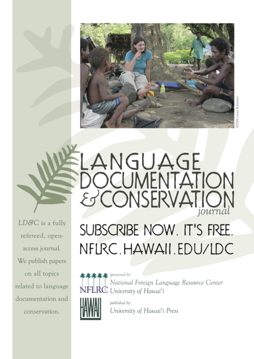
Language, Documentation & Conservation Journal
Volume 15 (2021)
The new issue includes the following articles and reviews:
Between Stress and Tone: Acoustic Evidence of Word Prominence in Kurtöp
Gwendolyn Hyslop
Automatic Speech Recognition for Supporting Endangered Language Documentation
Emily Prud’hommeaux, Robbie Jimerson, Richard Hatcher, and Karin Michelson
Using YouTube as the Primary Transcription and Translation Platform for Remote Corpus Work
Alexander Rice
Collaborative Fieldwork with Custom Mobile Apps
Mat Bettinson & Steven Bird
#KeepOurLanguagesStrong: Indigenous Language Revitalization on Social Media during the Early COVID-19 Pandemic
Kari A. B. Chew
Find more research articles and reviews at ScholarSpace.












